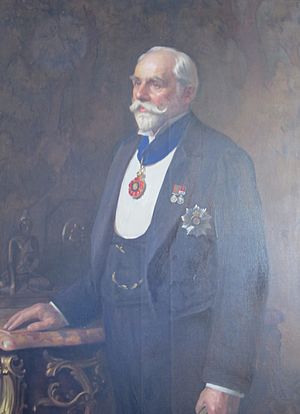Guilford Lindsey Molesworth facts for kids
Quick facts for kids
Sir Guilford Lindsey Molesworth
|
|
|---|---|
 |
|
| Born | 1828 |
| Died | 1925 |
| Nationality | English |
| Occupation | Engineer |
| Engineering career | |
| Discipline | Civil, |
| Institutions | Institution of Civil Engineers (president), |
| Projects | Royal Arsenal, Woolwich |
Sir Guilford Lindsey Molesworth (1828–1925) was an English civil engineer. A civil engineer designs and builds things like roads, bridges, and railways.
Biography
Early Life
Guilford Molesworth was born in Millbrook, Hampshire, England. His father was John Edward Nassau Molesworth, who was a vicar. A vicar is a type of church leader.
Guilford went to the College for Civil Engineers in Putney. After college, he learned his skills by working with experienced engineers. He trained with Mr. Dockray at the London and North Western Railway. He also worked with Sir William Fairbairn in Manchester. This training helped him become a skilled engineer.
Career Highlights
Molesworth became a top assistant engineer for the London, Brighton and South Coast Railway. But he soon left that job. He went to work on important building projects at the Royal Arsenal in Woolwich. This was during the Crimean War, a big conflict in the 1850s.
In 1858, he won two special awards. He received the Watt Medal and the Manby premium. These awards were from the Institution of Civil Engineers. He earned them for a paper he wrote about how machines could convert wood.
After working in London for a few years, he moved to Sri Lanka in 1859. By 1862, he became the chief engineer for the government railways there. From 1871 to 1889, he was a consulting engineer for the Indian government. He advised them on their State railways.
In May 1888, he received a very important honor. He was made a Knight Commander of the Order of the Indian Empire (KCIE). This meant he was given the title "Sir." He also received medals from the British Government. These were for his help during the Second Anglo-Afghan War and the Burma War. In 1904, he became the president of the Institution of Civil Engineers. This is a very respected position for engineers.
Railway Gauges
Sir Guilford Molesworth was often asked for his opinion on railway tracks. Specifically, he was asked about the "gauge" of the tracks. The gauge is the distance between the two rails. Railways can have a "narrow gauge" or a "broad gauge."
Molesworth usually thought that narrow gauge tracks didn't save much money. He believed that broad gauge tracks were better. He even built a broad gauge line to Kandy in Sri Lanka. He wanted to show that broad gauge tracks could work well even in steep mountains.

